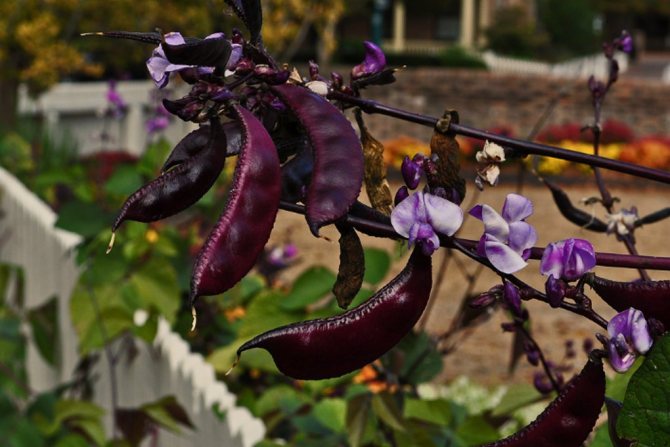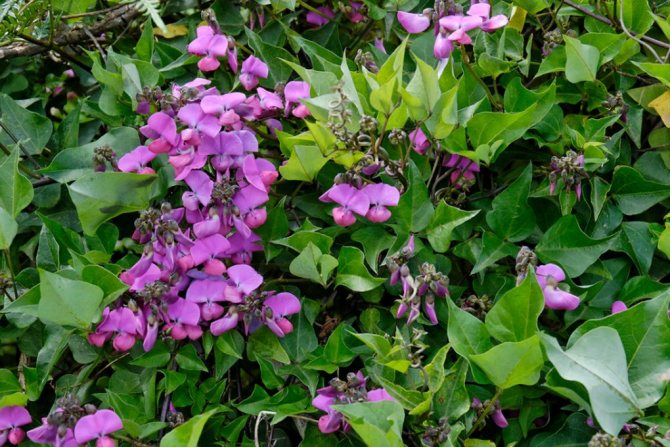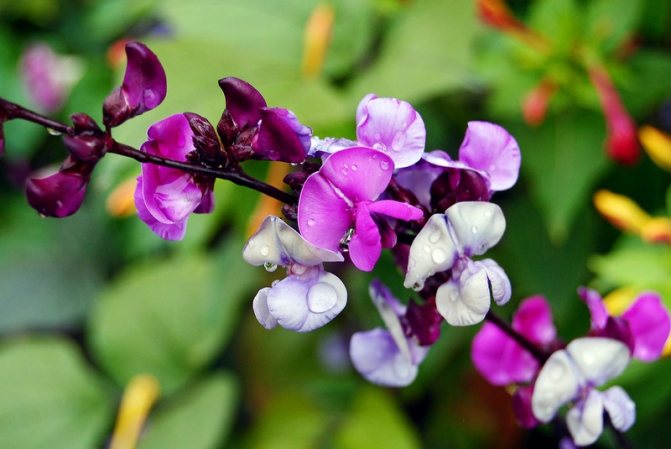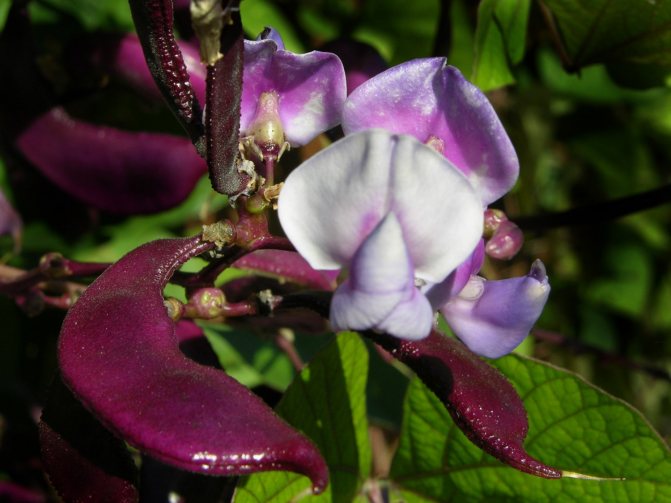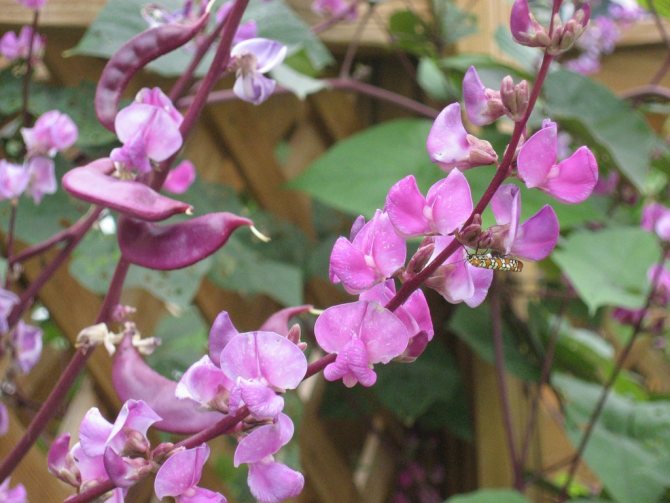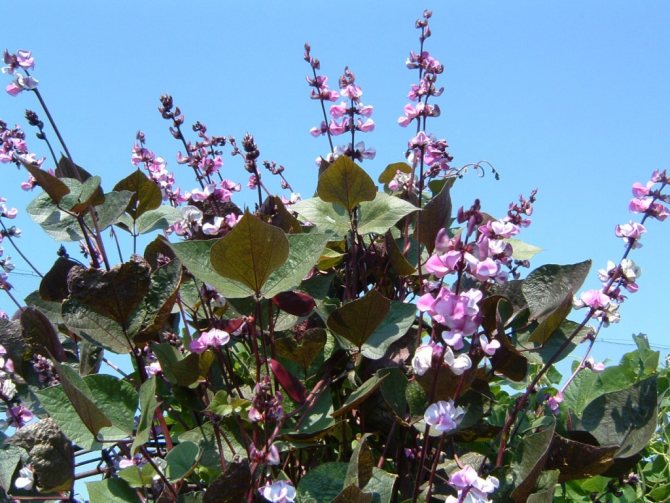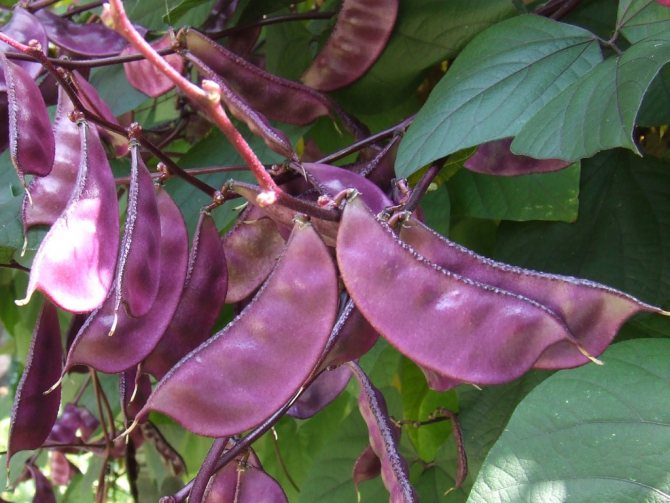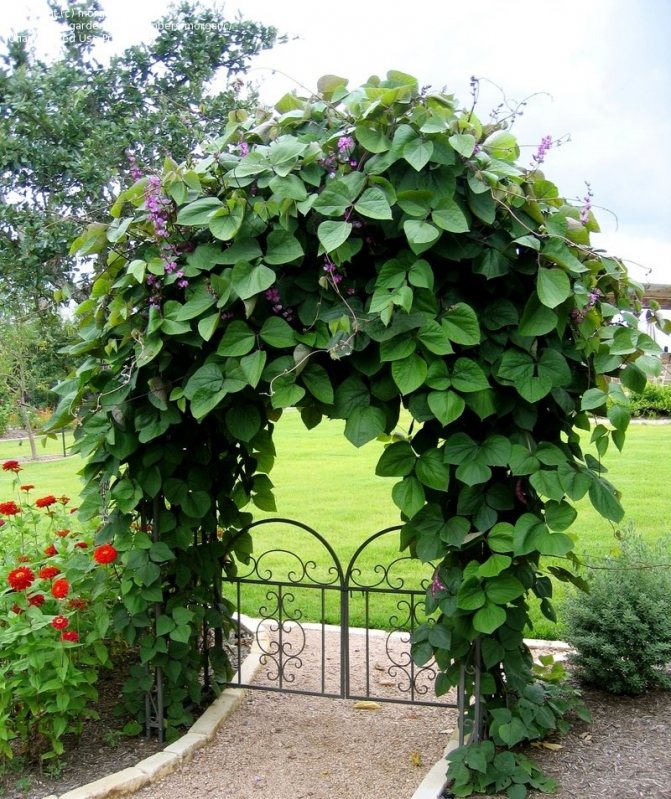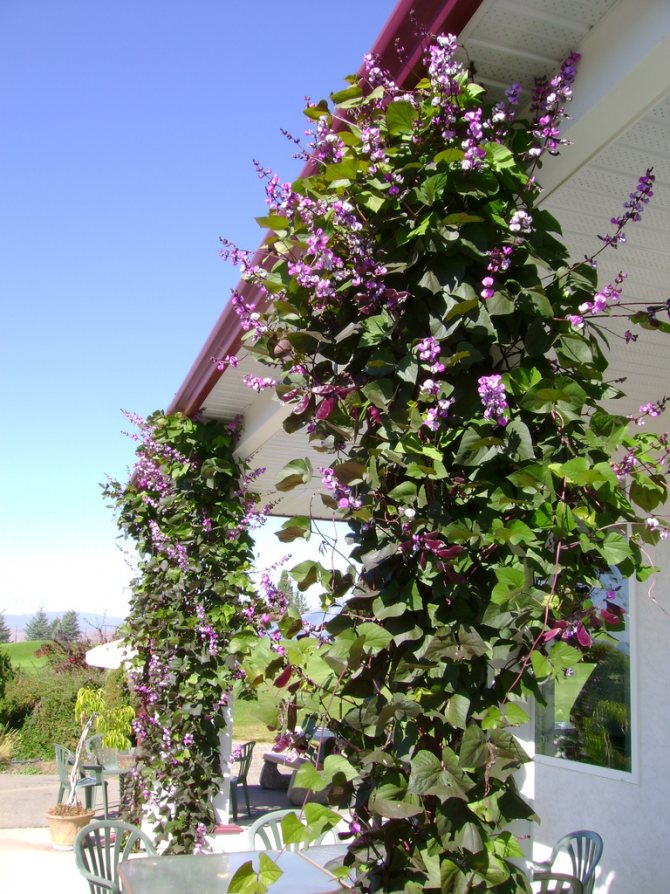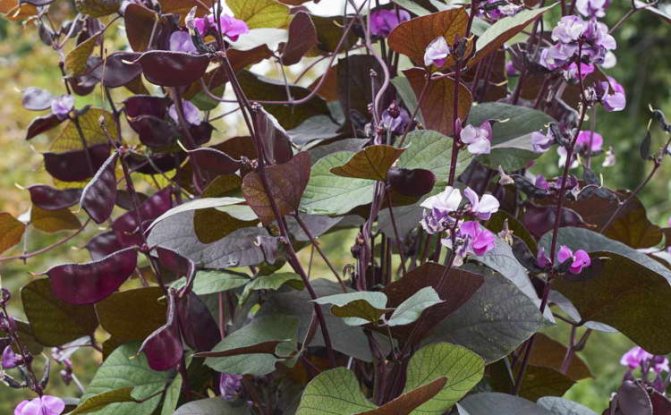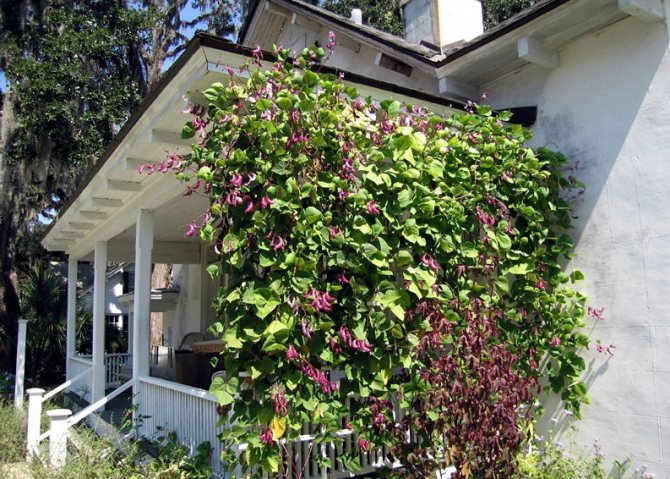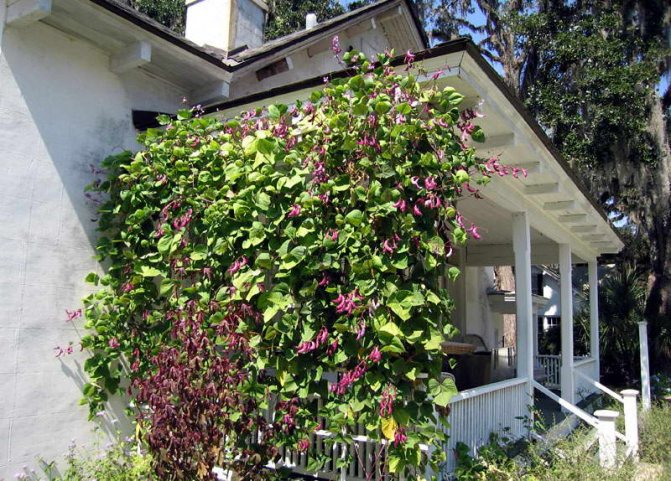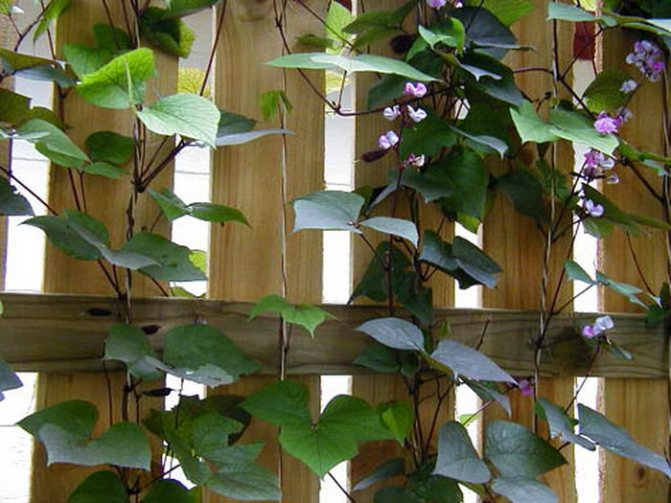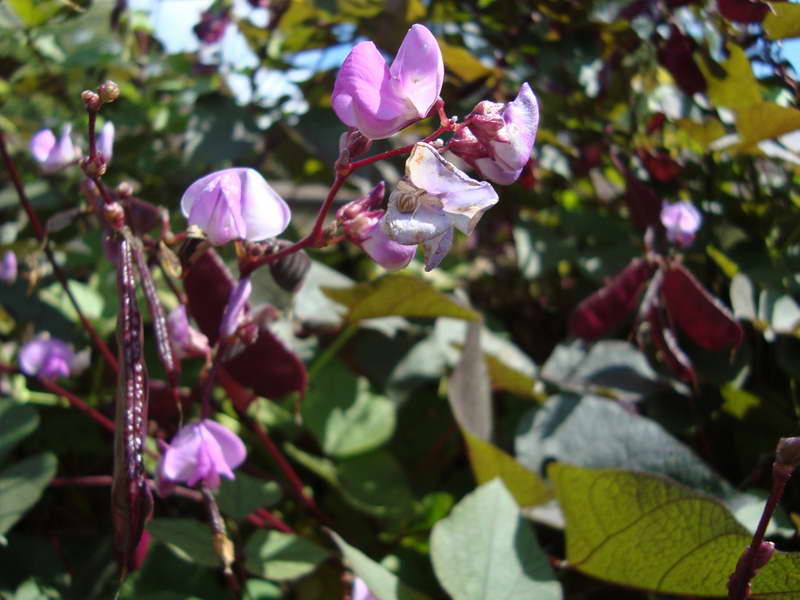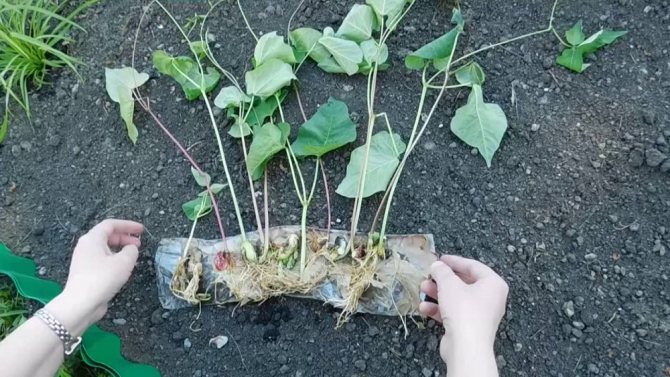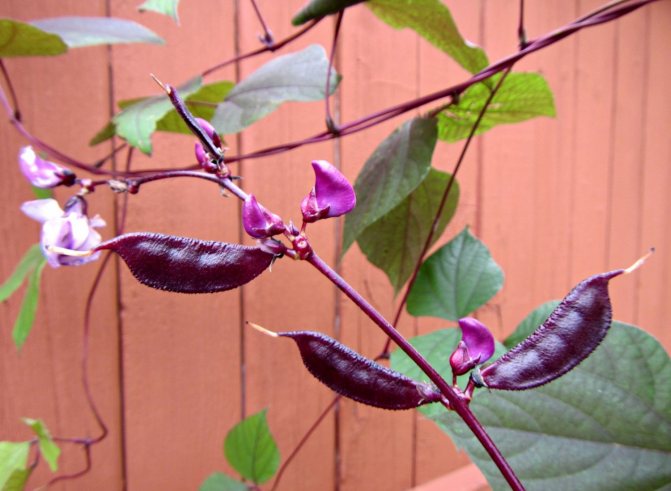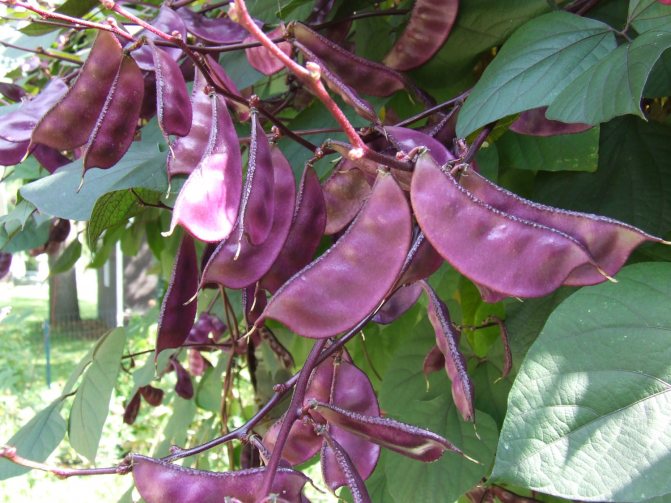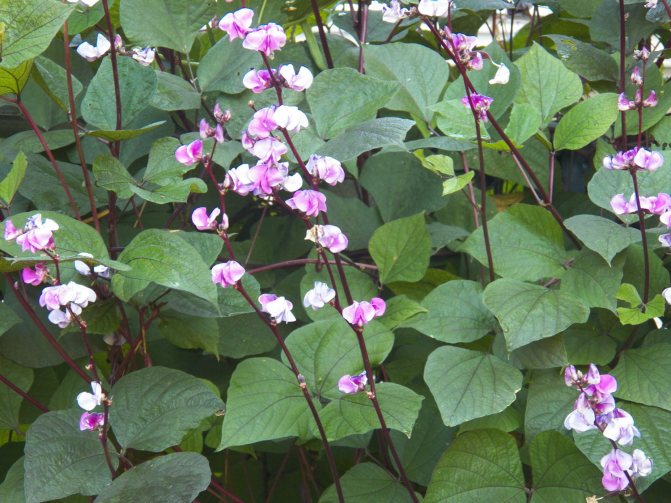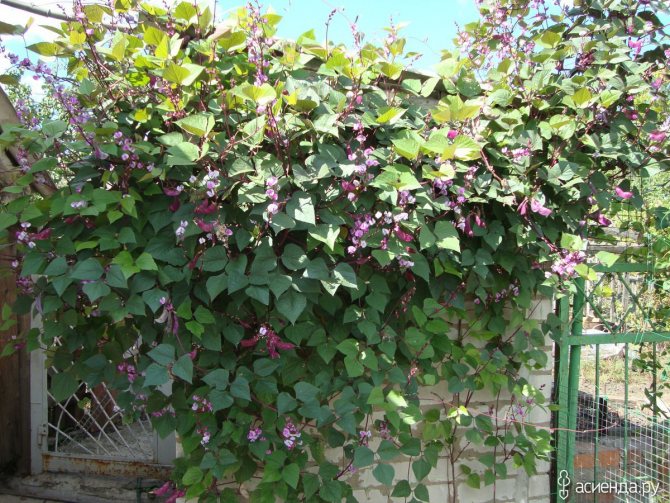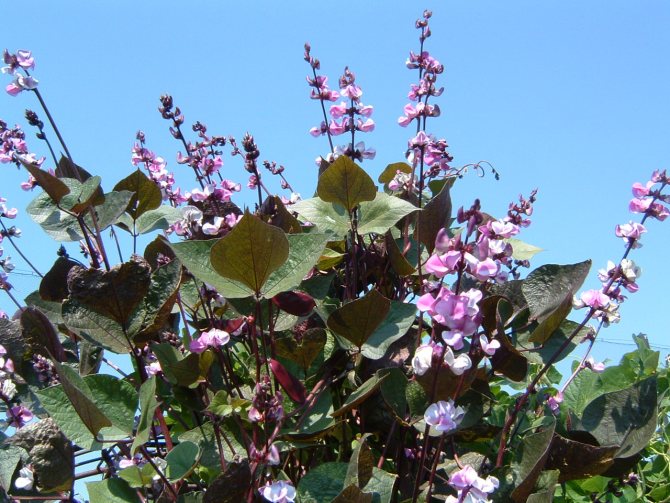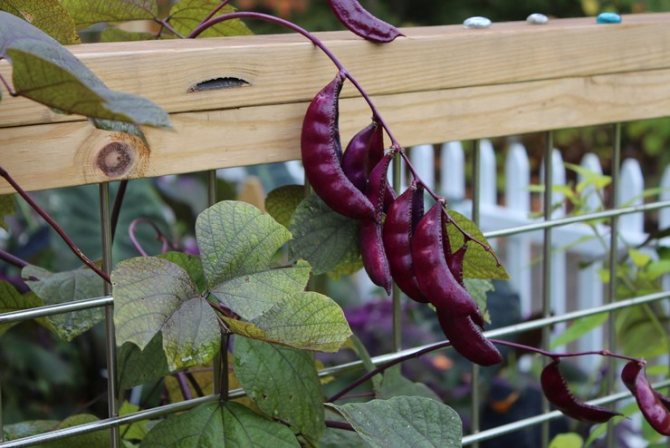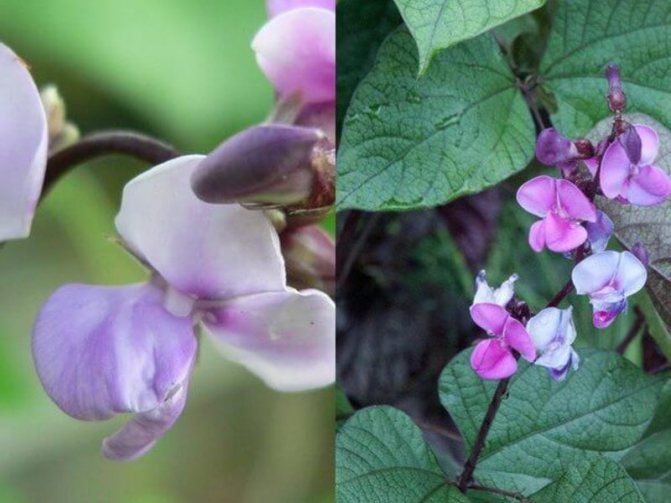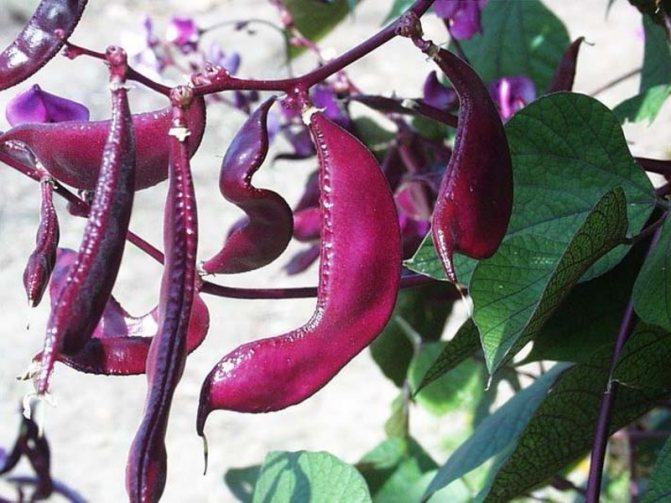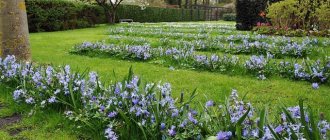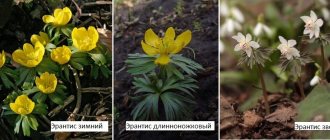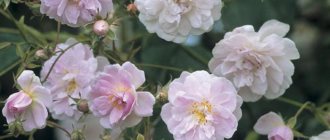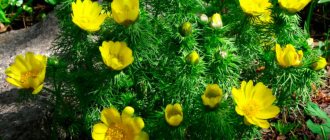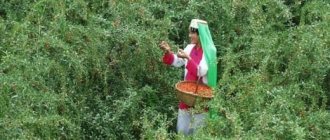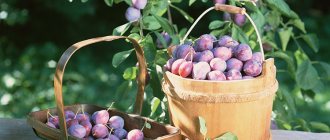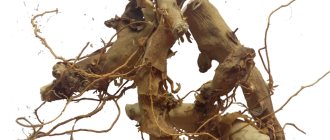Dolichos lianas are a climbing perennial of the legume family. Its other names are Egyptian beans, kokornik, curly lilac.
This plant comes from the subtropical regions of East Africa. In regions with warm winters, dolichos grows for several years, but in Russia it is more often cultivated as an annual crop. Dolichos begins to bloom around mid-July. Long clusters with many flowers emerge from long shoots. The flower is characteristic of all legumes with a pleasant delicate aroma.

Since dolichos is an ornamental climbing plant, its height reaches 3-4 meters, but sometimes there are specimens of 10 meters in height.
Description
Hyacinth (Egyptian) beans are a perennial vine in tropical and subtropical regions of the globe. In the conditions of central Russia, the loach grows during one season.
It belongs to the legume family and is a fodder, grain crop. It is used for its intended purpose in the countries of Asia and South America, from there the tradition began to place a lobium near the walls of buildings, to wrap arches, various supports with them.
The height of the dolichos bush reaches 3 meters (in natural conditions up to 10 meters), so it needs a garter. The leaves are large, heart-shaped, trifoliate. They are green and have red streaks. Long inflorescences are formed from the axils of the leaves; they consist of many fragrant bizarre flowers.
Their color is pink or lilac, purple or mixed.
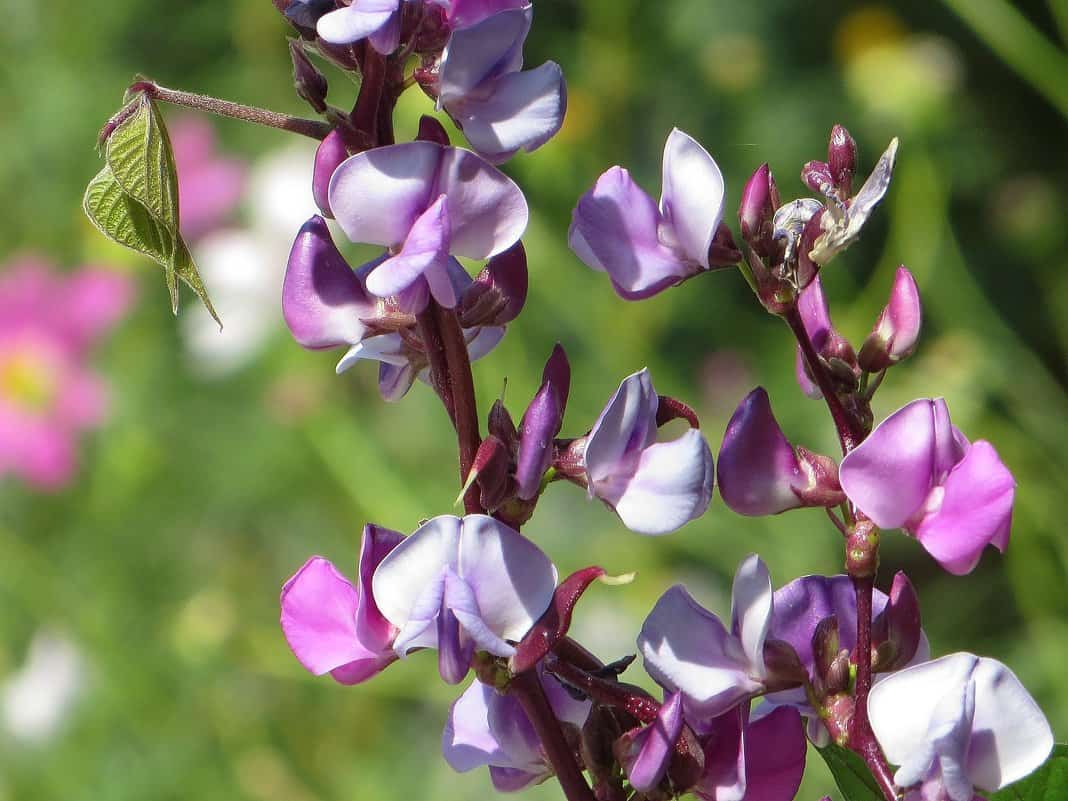

Interesting! The inflorescences are not drooping, they perkily look out of the lush foliage.
Several dozen flowers are on one peduncle, depending on the variety, they have a different color. My variety (the name is unknown to me) blooms in pink-lilac baskets, its stems are purple, and the leaves are reddish-streaked.
The fruit of the plant is a pod with beans, it ripens in the place of a flower. Shiny purple-purple pods blend harmoniously with foliage and flowers. This sight is magnificent: a riot of colors in all parts of the plant. Flowering begins in July and ends with the first frost.
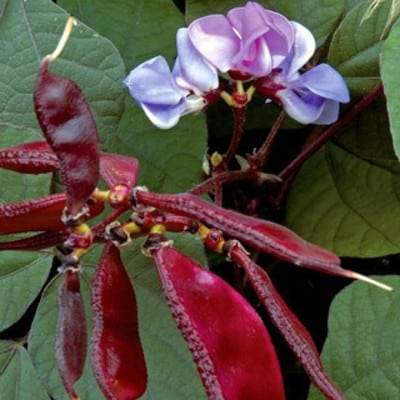

Pods of different colors (brown, black, brownish surface) with a white scar have an oval flattened shape and a length of 6 to 10 mm.
It will come in handy! Hyacinth beans are capable of fertilizing the soil. Cut off the faded ground part of the dolichos in the fall (you can grind it) and bury it in the ground to a depth of 15-20 centimeters. Grass and flowers are of the greatest value before and after flowering, but it is a pity to bury such beauty in the ground!
On the roots of the plant there are nodules of nitrogen-fixing bacteria, they convert nitrogen from the air into another form, which is necessary for assimilation by plants. Hyacinth beans are a green manure crop.
Outstanding varieties of dolichos (with photo)
As for the varieties, we will focus on the most popular of them. outstanding varieties of dolichos have long been identified by experienced flower growers, they do not require enormous effort to maintain.
Look further on the dolichos varieties in the photo and read the brief descriptions to be able to make the right choice.
"Pink Moon" is just the sort that resembles lilacs. The leaves are bright green and the flowers are bright purple. The stems of this variety reach a height of up to 4 meters, but they can be slightly higher.The advantage of this variety is that the stems hang even before the first snow appears.
"Lilac Cascade" - the variety is suitable for growing even in urban conditions, on the balcony. Plants are very resistant to cold snaps. It is more of an ornamental variety than a fruitful one, as it is valued for its branchiness.
"Purple garlands" - this variety is notable for the height of the stems up to 6 meters. Its peculiarity is in huge leaves and bright purple flowers that look like garlands (hence the name).
Some exterior designers use several varieties at the same time. This approach will perfectly complement any facade with beauty, which will now also become a support for a first-class and tasty harvest.
Where and how to plant
Dolichos is a lover of sunny areas, diffused shade. A heated place with loose fertile soil suits him very well. In our climatic conditions, this plant is grown only from seeds.
Since our summer is short, we sow hyacinth beans for seedlings in March or April. I plant in April (Ural), there is enough time left until summer for the seedlings to form and get stronger.
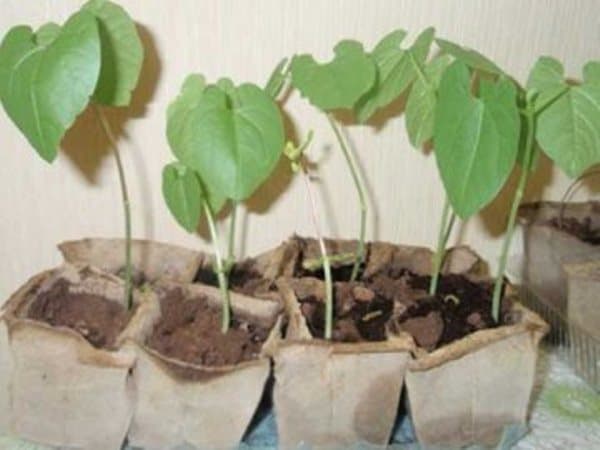

The day before sowing, I soak the beans in a small amount of plain water. Some people advise to subject the beans to scarification (damage to the outer shell), but I have never done this, I always have fresh seeds and they germinate perfectly.
- I take a container with drainage holes (you can use peat pots or tablets);
- I fill it with garden soil mixed with sand and humus (of course, a purchased substrate is also suitable);
- We put one bean in tablets and cups, and put them in containers at a distance of 6-10 centimeters;
- I deepen to a depth of 1-1.5 centimeters, sprinkle and water;
- You can use a cover with a film;
- The sprouts take a week or a little longer to germinate;
- If the weather is still cool, the seedlings have already grown, but planting in the ground is not yet expected, I pinch the top;
- I land in open ground when it is warm outside, the threat of frost has passed.
Advice! Plant dolichos in the evening or on a cloudy day, it will take root more easily.
It happens that the plants are planted in the ground, and the air temperature drops greatly. For example, it is now the beginning of June, hyacinth beans have already been planted (and outside 2-3 degrees), they stand - they do not budge, only the leaves are lifted up. On a particularly cold evening, I cover the plantings with non-woven garden material.
As I said above, we choose a permanent place in the sun for seedlings. We supply the land with organic matter in advance (I have humus), dig it up and level it.
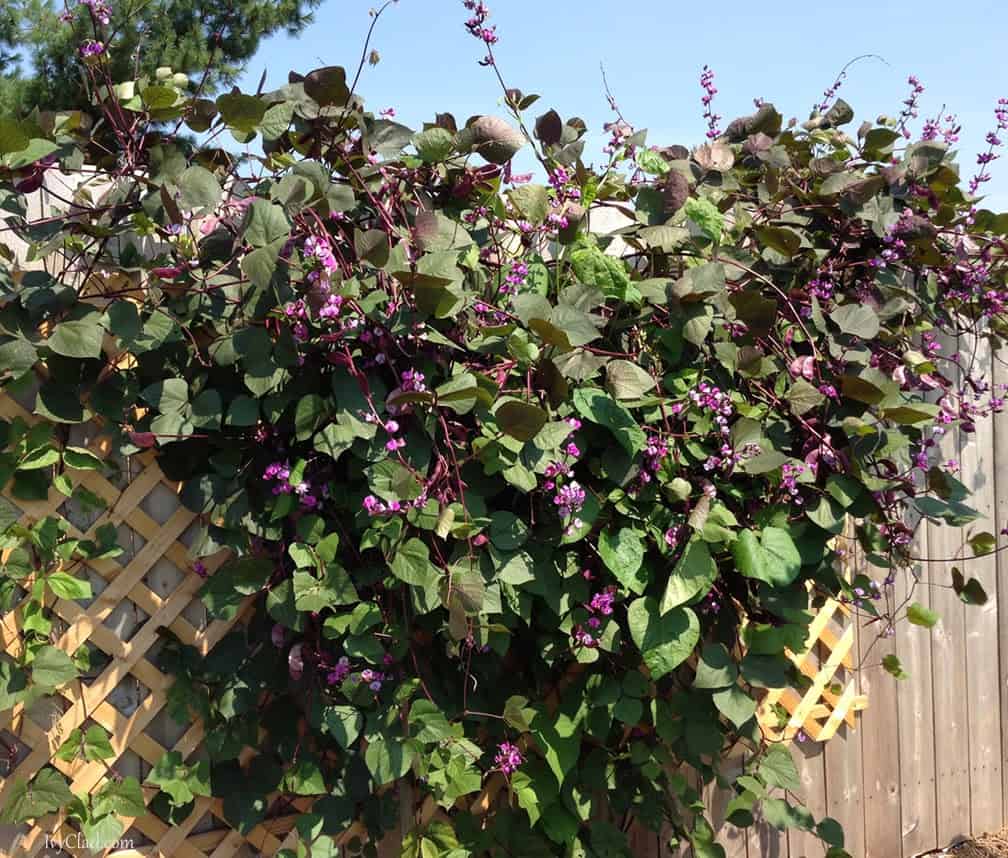

Dolichos needs support without fail, so in my garden he grows near the wall of the bathhouse. I plant plants in round flower beds at a distance of 15-20 centimeters (you can withstand more). Immediately I prepare the supports - I have stakes 30 cm long, and twine is tied to them (or another synthetic rope).
When the vine starts to grow (it does not give antennae), it will find support itself, only at the very beginning I help it "climb".
In open ground, hyacinth beans can also be sown in the middle lane, but the summer period has become so unpredictable and cold that I do not risk it. So little time will be left to admire the flowering.
But in the southern and southwestern regions, the plant is sown directly into the ground on the street. The principle is the same: we choose a place and prepare the soil, make supports.
Benefit
The medicinal properties of dolichos have been known since antiquity. Regular consumption of beans has a significant anti-inflammatory effect on the body. The product is aimed at:
- strengthening the protective function of the immune system;
- improves metabolic processes;
- regulates heart contractions;
- adjusts the level of blood pressure.
Mature beans have a balanced protein composition and are known for their amino acid composition.Its fruits are used as beneficial amino acids and minerals. Its complex composition contains lysine, which has an active antiviral and energetic effect, promotes tissue regeneration.
It is known for certain that mature dolichos beans have a beneficial effect on the function of the gastrointestinal tract, contribute to the normalization of food digestion processes, and help eliminate excessive gas formation and severe colic in the intestinal area. The beans of the unpretentious dolichos contain components that promote smooth weight loss and tone the body.
Dolichos beans belong to the group of slow-acting carbohydrates. It takes longer for the body to absorb them and convert them into energy. Locals believe that a natural decoction of fresh leaves of the plant effectively restores a woman's ability to reproduce. Dolichos normalizes the menstrual cycle, eliminates internal processes, and helps to accelerate the process of conception. The practical benefits of dolichos are well known in practice.
Cooking use
Ripe fruits are characterized by a high content of starch and proteins. Compared to beans, beans have a more delicate texture and milder taste. Unripe beans are used for food. Ripe fruits are used as side dishes, salad components, soups. Before cooking the beans, they are thoroughly soaked. Many recipes contain beans as a main ingredient in hearty dishes.
Why Soak Egyptian Beans?
Soaking the beans is necessary to increase the bioavailability of the product in order to increase the nutritional value of the fruit. There are several reasons for soaking beans:
- increasing the nutritional properties of the product;
- reducing the risk of developing inflammation and facilitating digestive processes;
- prevention of the development of insulin adhesions, which became possible due to a decrease in the amount of sugar in legumes after soaking;
- filling beans with life energy.
How to soak ripe dolichos beans correctly? To do this, select the fruits, place them in a container, fill them with water so that its volume is 2 times larger than them. 1 teaspoon of apple cider vinegar will help speed up the soaking process. The total period of soaking is 12 hours.
How to care
This vine loves watering, especially before and during flowering. I water it at the root. Simultaneously with watering, you can feed the dolichos with mineral solutions containing phosphorus and potassium. We perform all manipulations without touching the leaves. You can use granular fertilizers, they gradually dissolve, feeding the bush.
I mulch the soil under the bush with humus, sprinkle with ashes. If you do not need seeds, we cut off the dried pods and throw them away.
They can be collected, dried and used for planting. Dried fruits removed in time, contribute to the ovary of new peduncles.
To eat beans, they need to be planted in large quantities, and this is unusual for us. Although hyacinth beans are used in cooking and are included in the national cuisine of many Asian and South American peoples.
What is sick
From waterlogging, drought or thickening of plantings, as well as from neighboring plants, dolichos is affected by powdery mildew, spotting.
You can resist this if you noticed an ailment at the very beginning. Spray the plant with a soapy mixture with copper sulfate. We also use Bordeaux mixture.
Hyacinth beans are sometimes attacked by aphids or nematodes. A chemical method - insecticidal preparations - will help from their invasion. For prevention, folk methods are good: dusting or spraying with wood ash or tobacco.
On a note! I advise you not to be afraid to grow hyacinth beans, they rarely get sick. Proven by experience!
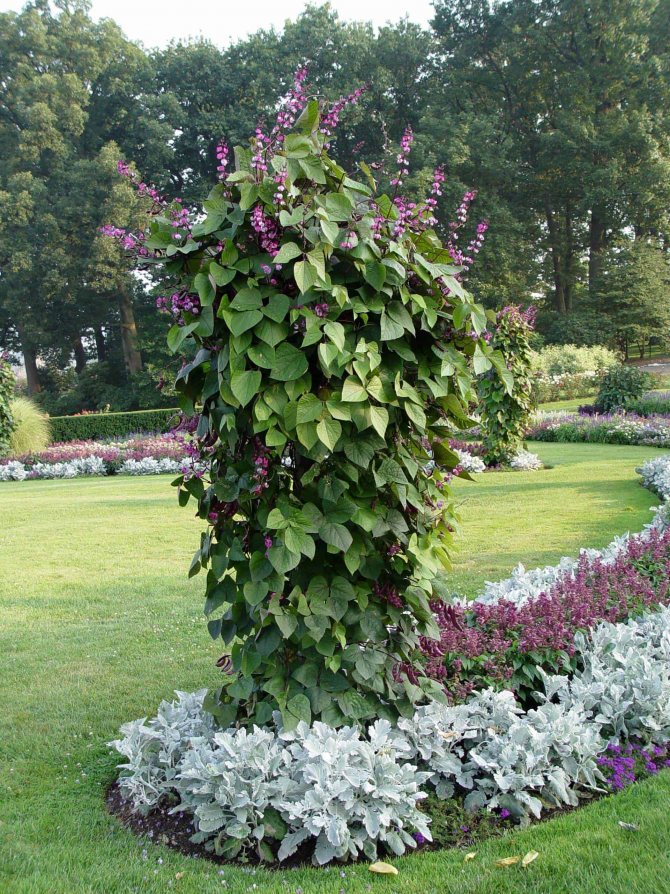

The use of the plant for culinary and decorative purposes
Dolichos fruits are edible and prepared according to the same recipes as beans
Dolichos fruits are cooked like beans or beans, they are rich in protein and nutritious. In Georgia, one of the national dishes is made from them - lobio.
Beans soaked for several hours are used to prepare first courses, they are added to vegetables in side dishes. Green pods are marinated, fried, baked, used as a separate side dish or as part of a complex side dish for meat, they are included in salads. Dried beans are stored well and for a long time, while boiled beans are frozen or canned.
American scientists recommend using dolichos fruits in weight loss diets.
Ornamental plants are used to decorate high fences, they are widely used for vertical gardening of houses, shady gazebos, they are used to decorate garden and park forged or wooden arches, pergolas. With the help of various supports, vines can be given any shape. Old fruit trees look original, on which, for example, apples or pears and lilac pods grow at the same time.
Dolichos looks especially colorful in early autumn. On the bushes, you can simultaneously observe young greens of the tops of the shoots, yellowing lower leaves, delicate buds and bright clusters of inflorescences, as well as colored legume pods.
You will get acquainted with the intricacies of planting and growing dolichos by watching a video clip. Happy viewing!
Planting hyacinth beans
The main condition for growing a crop is the correct choice of soil. It is best to choose a fertile soil with neutral acidity.
Important! In no case should you plant beans in acidic soil. This will significantly slow down the growth of the plant and most likely it will not bloom.
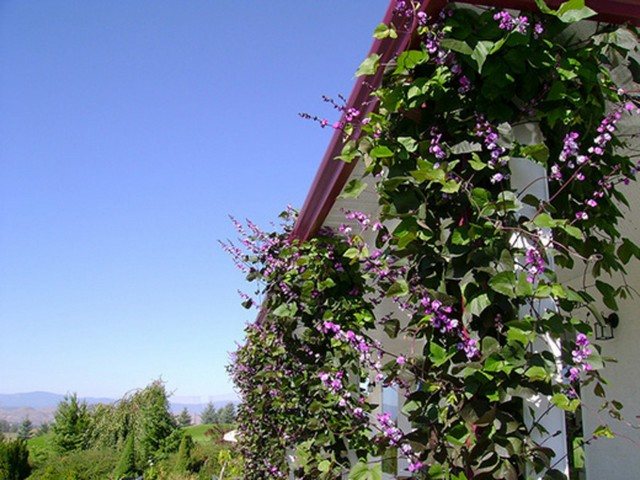

To germinate the beans, choose a warm location with adequate access to sunlight without drafts. The soil for planting curly lilacs can be prepared independently by mixing the following components in equal proportions:
- Chernozem;
- Shredded humus;
- River sand;
- A mixture of high-moor and lowland peat.
Seed sowing of hyacinth beans is recommended to start with heat treatment of the soil. At a temperature of 200 degrees, the soil is heated in the oven for 40 minutes. The treated and disinfected soil is poured into special seedling containers and slightly moistened. Next, 2-3 dolichos seeds are planted in each container to a depth of 1 cm and covered with cling film until the first shoots appear.
If scarified seeds of hyacinth beans were used for planting, at a germination temperature of 22-25 degrees, the first shoots appear in a week. When the first sprouts appear, the seedling containers must be rearranged in a place well-lit by daylight. Further care consists in moderate watering as the soil dries out. Seedlings obtained from seeds should be planted in late May or early June, when the ground is fully warmed up.
Climbing beans are very thermophilic plants. The landing site should be protected from cold winds and sufficiently illuminated by the sun. In the first days after planting seedlings, the soil must be thoroughly moistened. In hot weather, watering is carried out daily.
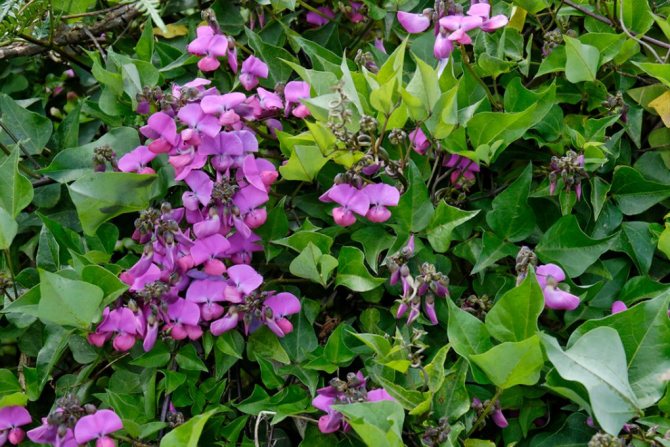

During the flowering period, the plants require weekly feeding with superphosphate. This contributes to a more lush blooming of dolichos flowers. Flowering begins in mid-summer and continues until late autumn. Lush flowers of the shrub gather in large inflorescences.
Fact! One inflorescence can contain about 50 fragrant flowers of the plant.
A big advantage over other flowering shrubs is the plant's resistance to various diseases and pests. The only problem that gardeners may face are yellow dots on the leaves, indicating a lack of potassium in the soil. The most common fertilizers will help to eliminate it.
The cultivation of hyacinth beans will not only decorate the summer cottage with lush fragrant flowers, but also give a lot of aesthetic pleasure!
Views
Dolichos Lablab (Lablab purpureus, Dolichos lablab) - the genus Lablab was transferred to another oligotypic species by botanists, although it was previously considered as the genus Dolichos.
Dolichos narrow-leaved
Dolichos angustifolius - narrow-leaved dolichos, characterized by long, almost bare vines, the stem branches poorly, with complex narrow-lanceolate leaves. Peduncles are short with 2 to 4 flowers, filiform, purple in color.
Dolichos trinervatus
Dolichos trinervatus - Dolichos has erect stems that sprout up to 1.3 m in height from a woody perennial shoot. Leaves are pinnately three-leafed, narrowly elliptical, oblong in shape. The flowers are purple lavender.
Dolichos trilobus
Dolichos trilobus is a creeping, weaving stems, sometimes sprouting in the internodes. Annual stems sprout from a lignified stem near the roots. Leaves, 3 pcs per handle, wide, ovoid. Flowers from reddish-lilac to purple-blue.
Leaving competently
Further care for the planted hyacinth beans (lobio) consists in covering the plants with plastic wrap in case of unexpected drops in temperature, in timely watering, in the treatment with insecticides against aphids or other leaf-sucking insects.
Once every 10 days, the beds or flower beds where the liana is planted are weeded to clean the soil from weeds. Two weeks after planting, young vines need to be covered with soil to a height of 20 -25 cm. This will allow the plant to build up additional root mass, which will have a positive effect on its development and growth.
Watering
All legumes in dry soils or soils with poor watering slow down or even stop their growth. Do not allow the root layers of the dolichos to dry out. If the gardener does not have the opportunity to ensure regular watering of the vines, then measures must be taken to retain moisture. For example, lay mulch at the foot of the plants. For mulching, you can use old, unnecessary remnants of roll wallpaper. The paper prevents the evaporation of water from the soil, allows water to pass through during irrigation and delays, or even completely prevents the growth of weeds.
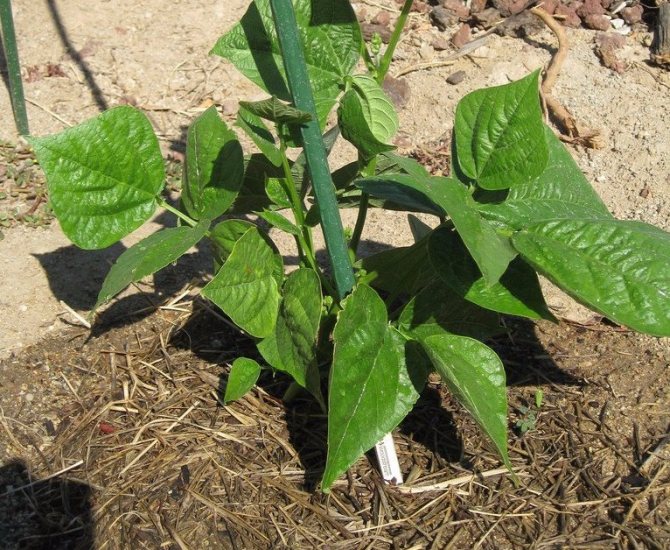

For not laborious and long-term watering, gardeners use plastic bottles from mineral water. Under each liana, such a bottle, previously filled with water, is placed on a barrel. For subsequent watering, slightly loosen the closed cap on the bottle. Adjust the opening of the lid until water is supplied to the plant drop by drop. There is enough water in the bottle for seven days of irrigation, while the moisture will not spread, wet the upper layers of the soil. Drip irrigation gradually moistens the soil near the creeper to the deep subsoil layers, which means that water flows to the roots.
Support
As soon as all the vines are spud, a reliable support must be installed near each plant. Climbing lilac is called so because this plant, while developing, tends upward. To do this, hyacinth beans have special tendrils with which plants cling to a support, plants growing nearby, recesses in the walls of houses or openings of a netting mesh.
It is necessary to comfortably arrange climbing vines so that they can grow up unhindered and show themselves in all their glory.
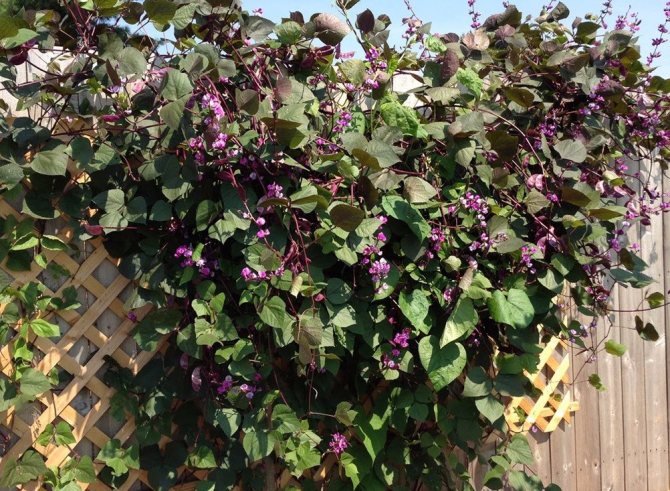

Here are several options for such supports for creepers:
- the trunk of a dry tree growing nearby;
- metal mesh-chain-link with wide cells;
- wooden pegs, three meters high;
- stationary high trellises (as for tomatoes);
- beautiful wooden lattice portable pyramid supports.
Top dressing
A month after planting seedlings on the street, the plant needs feeding. Any complex mineral fertilizer for flowers or vegetables is suitable for feeding.
You can use natural organic fertilizing:
Option number 1
Fill half of the 10 liter bucket with chicken droppings. Fill the contents of the bucket with water to the top. Mix thoroughly. Place the bucket in a sunny place for subsequent fermentation and cover with a lid. After a week, the concentrated fertilizer is ready.
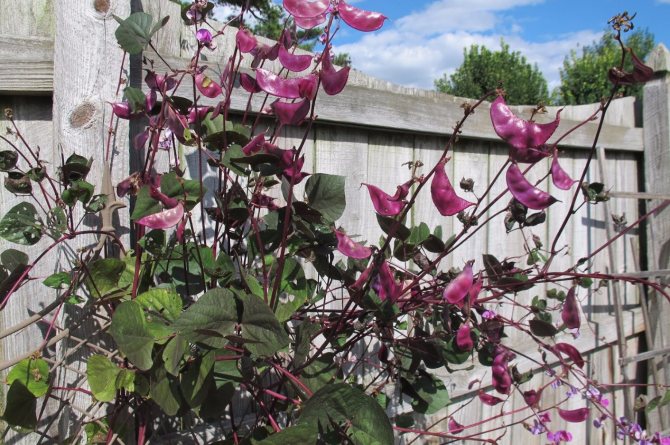

To fertilize plants at the root: add 0.5 liters of concentrate to 10 liters of water. Stir. The fertilizer is ready for use. The diluted solution must be used immediately, since during long-term storage, the most important component, nitrogen, will disappear from it.
Important! This fertilizer is suitable not only for legumes, but for all flowers and vegetables.
Option number 2
A large container is filled with weeds from the garden to half. Garden nettles are very good for green fertilization, but any weeds will do. Next, the barrel is poured to the edge with water and the covered barrel is left to ferment for two weeks. Periodically, the contents of the container are stirred with a wooden pole, since the solution must be enriched with oxygen.
The finished solution is also a concentrated fertilizer. Before watering, top dressing must be diluted: add three parts of water to the fourth part of the present green concentrate.
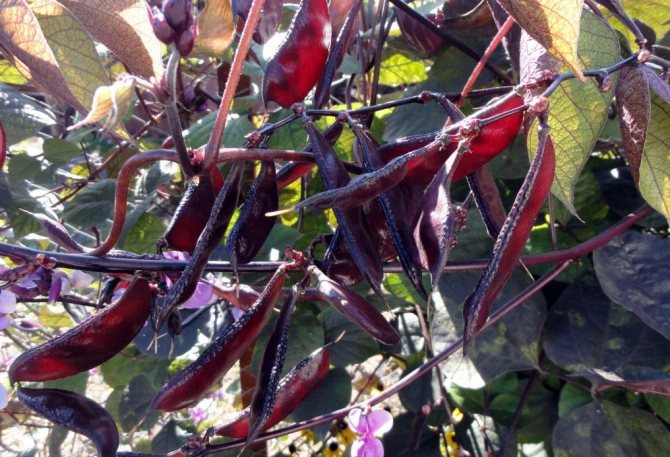

general characteristics
- The climbing plant has a branched rhizome with shoots similar to cords with seals. Stems are weakly branched and covered with red-brown bark. There are no antennae on the shoots, and they twine around the support in a circle counterclockwise.
- Petiolate leathery and rough foliage is located along the entire length of the shoot. Dark green in color. Sometimes purple stripes are located in the middle of the leaf.
- Curly lilac bloom begins in the middle of summer. The clusters have many colors and bloom on the top of the shoots in the axils or at the ends of the stems.
- There are 35 - 40 buds and they are quite large in size. The flowers have a delicate and sweet scent. Each of the brushes blooms actively up to 3 weeks. Then it is replaced by another dolichos inflorescence, and, thus, until the first cold weather, the plant pleases with beautiful pink, white and purple moth flowers.
- When pollination ends, the fruits are tied - flat burgundy pods up to 6 cm long. The beans are very original: black, beige or cream with white edging around the edges.
Growing a flower
Hyacinth beans are an unpretentious plant that does not require constant attention, but in order to get a truly worthy specimen, some care will still be required.
The dolichos flower is grown in seedlings, since it is thermophilic and does not tolerate cold weather, the optimum temperature for the normal development of the plant is 20-30 ° C. Hyacinth beans form additional roots extremely weakly, therefore, propagating them using cuttings is a very troublesome and thankless job.
To plant a flower in open ground, it is necessary to prepare seedlings.
Seedling preparation
For normal flower growth, a neutral or slightly alkaline soil is needed. It is advisable to add a little wood ash or chalk to the soil. Seeds are planted to a depth of 3 cm at a distance of 4-5 cm from each other. Watering is carried out as needed, usually to maintain the desired condition of the soil, it is enough to moisten it once a week.
Store pots with seedlings in a well-lit place at temperatures above +20 degrees, for example, on a balcony or on a windowsill. Already when growing seedlings, young plants need to install small supports. Planting climbing lilacs can also be done in a seedless way, in this case, the beans are planted on a prepared site in May, when the soil warms up enough, but then the seedlings germinate for a long time and develop slowly at first.
Flowering in this case begins later, around the end of August, and the ripening of the beans does not occur completely, which is a threat to the collection of high-quality seeds for use next year.
Flower care
The optimal time for planting seedlings in open ground is late May - early June, for this they choose a sunny, unshaded place. If there is not enough light, the growth of the flower will be greatly slowed down and flowering may not occur at all. Dolichos is very thermophilic, cold drafts and gusty winds are also unacceptable for him.
Hyacinth beans do not tolerate strongly acidic or alkaline soil, the optimal PH for them is neutral. It will be useful to loosen it and add humus before planting in the ground. Watering is done often: 2-3 times a week with a small amount of water, even more often in severe drought, while excessive moisture should not be allowed - it complicates the access of oxygen to the roots.
The soil should dry only on the surface, and to improve aeration, weed and weed should be regularly carried out.
Ripening and harvesting fruits
If the plans include constant cultivation of this culture, then it is better to harvest beans for sowing at home than to buy in a store, since in the second case there is no guarantee that ripe seedlings are collected in the package. As a result, although the dolichos will grow quite tall, its flowering will not be abundant.
After harvesting the first harvest, it is advisable to shorten the main stems in half, this stimulates the growth of the flower and makes it possible to harvest the fruits several times.
Diseases and pests
Curly lilacs are unpretentious in care, but, despite their rather high resistance to diseases and insect pests, they can still occasionally be exposed to them. Powdery mildew manifests itself in the form of white spots on the leaves, and you can get rid of it in several ways:
- using systemic fungicides;
- Apply natural remedies such as a decoction of horsetail or garlic.
To prevent the appearance of this fungus, simple care is needed:
- removal of fallen leaves;
- watering is done directly under the root of the plant.
With the appearance of yellow spots, the flower reacts to a lack of potassium, then the appropriate fertilizing with potassium-containing fertilizers is made. From insects that harm the plant - aphids, caterpillars, nodular root nematodes, red spider mites and whiteflies can appear in the shade. You can destroy them by treating the plant with insecticides.
Growing from dolichos seeds: everything you need to know about how to start
Dolichos - hyacinth beans, they got this name due to their decorative properties. After flowering has passed, the first fruits appear, which are in the form of wide flattened pods.
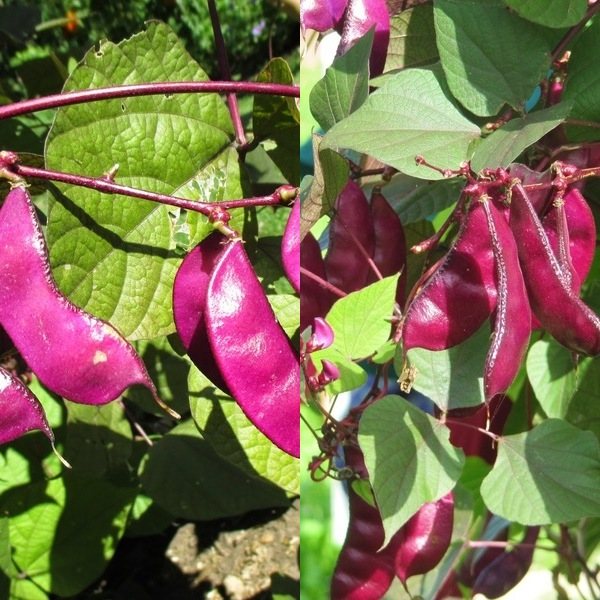

They are very beautiful - painted in an elegant burgundy color. Sometimes they have a pronounced purple tint. In stores, it is also sold under the name "Hyacinth Beans".
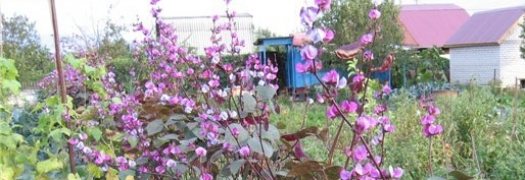

Growing dolich from seeds begins with the right choice of planting material. Seeds are sold in small packages. Usually there are no more than 3-4 of them per pack. This is because the pods of the first-borns, which are best ripe, are used for sowing.
Growing hyacinth beans at home
Growing hyacinth beans from seeds is within the power of every beginner. Care consists of weekly feeding and moderate watering. It is possible to grow homemade hyacinth beans not only in the country, but also at home. With proper care, the moth petals of this plant will decorate the balcony until the very late frosts.
For balcony maintenance, the Lilac Cascade variety is best suited. Shrub is grown through seedlings. Sowing seeds begins in April or early March. In early May, the seedlings are already completely ready for transplanting into open ground.
On a note! An adult dolichos begins to bloom in May and lasts until the end of August. Duration of flowering of one flower is 3-5 days, and the brush is about three weeks.
In order to preserve Dolichos in winter, it is advisable to use a spacious tub for its maintenance.
Spread
The natural habitat of the kokornik is due to the plant being in the warm climate of the tropics or subtropics. In warm conditions, the plant is perennial, constantly flowering. The plant can be found in temperate climates, but in this case the dolichos grows as a hybrid annual representative of the genus. You can meet a liana growing in its natural environment in the eastern part of Africa and Western Asia. Some species grow in Egypt.
The plant predominates in rocky mountainous areas. Dolichos takes root well in both arid and humid environments. It is possible to meet the kokornik as on the slopes of the mountains, in the hills or in the lowlands of rivers.
In Europe, climbing lilac grows in a hybrid form. Dolichos is often grown in the southern regions of Russia, in the Caucasus or in the Krasnodar Territory.
End of the season, and what happens in the end
Dolichos can be both annual and perennial. It all depends on the variety. His seedlings can serve a gardener for a very long time.
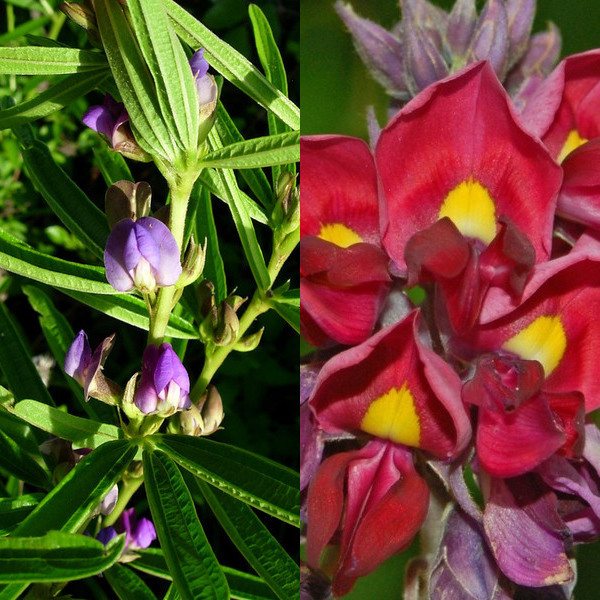

In addition, delicious and healthy dishes can be prepared from the beans that the plant brings.
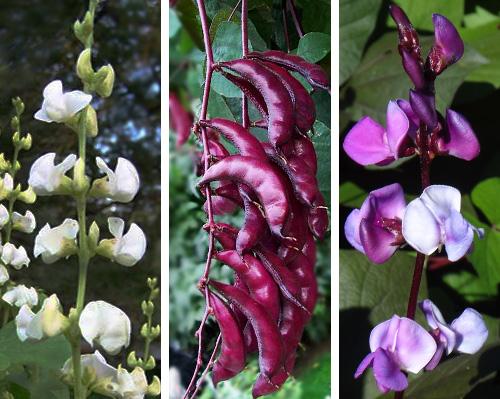

Dolichos needs a lot of care, but these efforts are worth the result!
The end of the summer cottage season is coming and what happens in the end in the basket of a hardworking grower is a wonderful harvest of legumes.
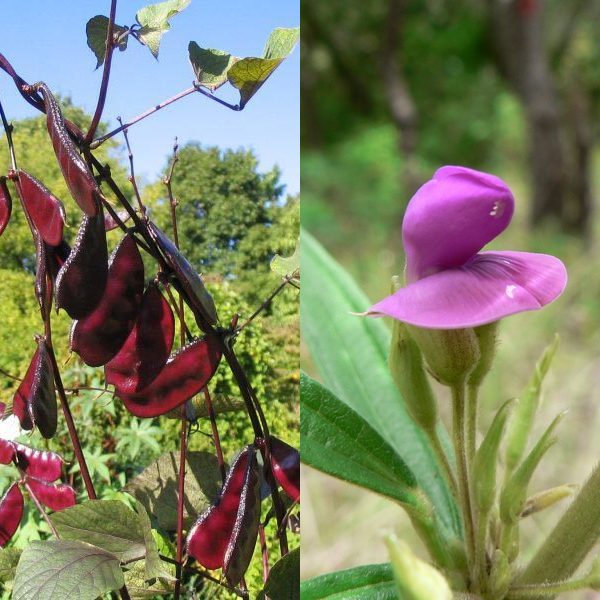

You need to cook them, like ordinary beans, first soak in water and cook for an hour. Due to their high protein content, which is not found in plants, these beans are great for replenishing strength. They renew human energy, replenish the body's supply of vitamins and lower blood cholesterol levels.
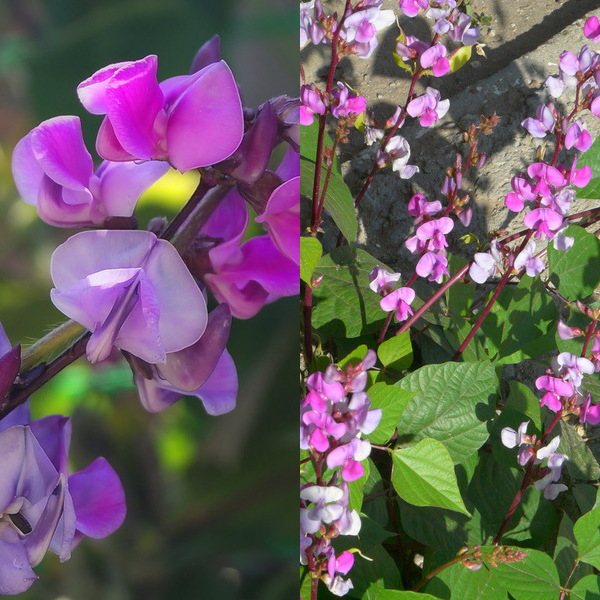

Dishes made from these beans are very useful for those who suffer from diabetes mellitus and various liver diseases. All thanks to the protein, which in structure resembles animal protein. It is known that the protein in plants is flawed, but in these beans everything is different. Therefore, dishes based on these fruits are popular with vegetarians.
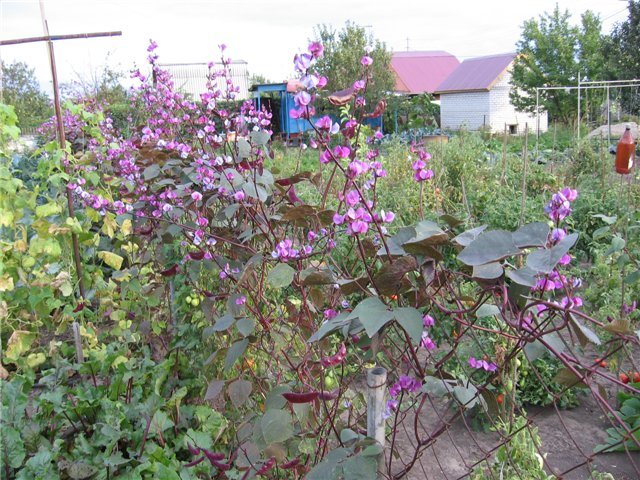

Bean pods are also healthy and can be eaten by adding them to salads right from the garden. You can also freeze these beans. Scientists have proven that when frozen, these beans acquire even more beneficial properties, which is also not typical for plants.
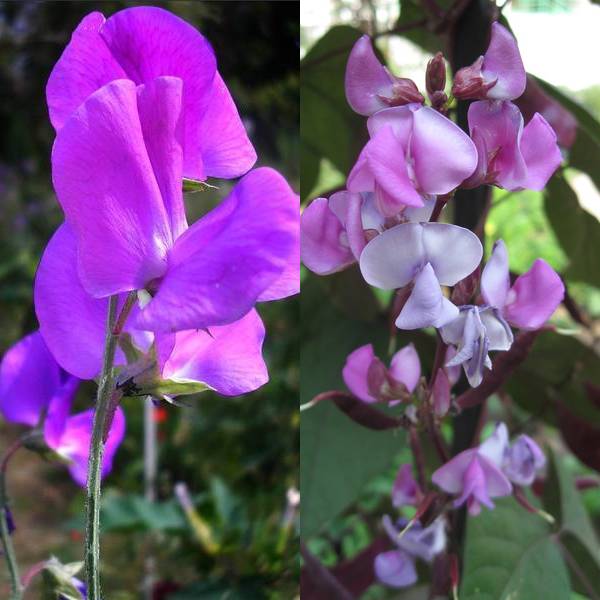

By planting such a plant, the following is obtained: beauty, throughout the summer and autumn, as well as a delicious harvest. If you take care of the seedlings throughout the entire time, you can get a very rich harvest, which will delight you throughout the year. A piece of summer can be saved for the winter.

